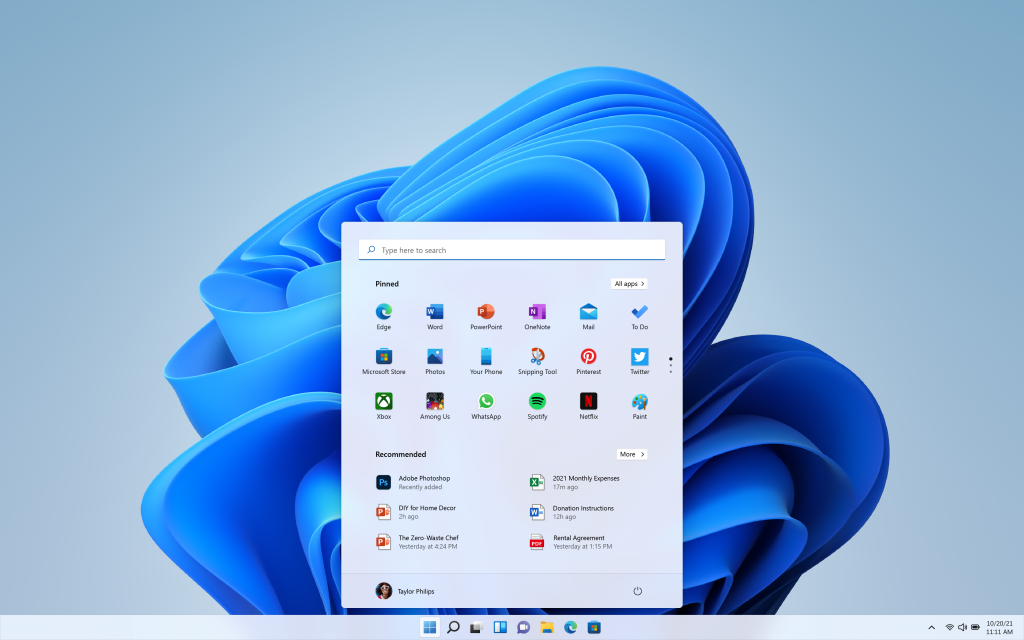
Glassy Overhaul - Windows 11
After weeks of speculation, on 24th June, Microsoft finally unveiled Windows 11, their new flagship operating systems. By this time everyone was already expecting it as a build of Windows 11 leaked a week earlier. Now, let’s see what is new in Windows 11 and when it will be available for the public.
The most noticeable difference is the iterative UI changes. Windows 11 leaves behind the square Metro theme and the new theme has more in common with Windows 7’s Aero theme than WIndows 10. There are rounded corners everywhere and microsoft also emphasized the transparency effects by comparing them to sheets of glass.
The start menu and the taskbar icons are now centered, though it can be aligned to the left if you prefer. The Start menu also got a nice upgrade with less clutter as they have switched back to icons rather than Live tiles. It still has web search integration into the start menu search which I personally hate but the start menu is now better and cleaner than Windows 10. Another addition is that now Microsoft Teams is built right into the taskbar and this is nice if you are a Teams user.
Now coming to some productivity features, Windows now has a tiling feature which can tile your open windows in pre-set layouts similar to the Windows 10 Power toys program. It also allows you to have those tiled windows bundled together in the taskbar.
Windows also has gotten smarter with external displays as it will now remember your window layout and minimize them when you disconnect from a monitor instead of randomly rearranging your windows when you connect/disconnect from an external monitor.
Windows 11 also allows you to have different desktop backgrounds for your different Virtual Desktops (or Workspaces) and switching between them is also easier as they are now lined up at the bottom right above the taskbar.
Windows 11 also comes with better touch and stylus integration with larger touch targets and more spacing making it easier to use for tablet and 2-in-1 users coming from Windows 10.
The Microsoft store has also got some updates with a much cleaner UI and also support for running Android apps natively through the Amazon App store. It is still not clear whether sideloading from an apk file is possible or not.
The widgets panel is another new addition to Windows 11 which is similar to the News and weather panel that many Windows 10 users have seen in the recent update, but the Widgets panel is much more Cleaner looking and slides out from the left side of the desktop.
On the Gaming performance side, Windows 11 now supports Direct storage which allows your Graphics card to directly access the game from the Hard drive or SSD bypassing the need of accessing the CPU which will result in faster game load times.
Windows 11 will be available as a free upgrade for all current Windows 10 users but the system requirements for compatibility are a bit higher than Windows 10. And I am not talking about easily upgradable components like RAM or Storage but Windows requires TPM(Trusted Platform Module) 2.0 or higher motherboards. The compatibility picture is still relatively unclear right now but Microsoft will probably provide clearer system requirements in the days to come.
If you want to try out Windows 11, The development build is available through the Windows Insider programme. You can sign up for it easily and once signed up, it will appear as an update ready to download and install. This is an unstable build so use it on a secondary machine or in a VM.
I feel that this new release of Windows is certainly a step in the right direction. The simplification of all the Metro UI elements from Windows 8 and 10 is really good. There are still things that I dislike about this release, such as the same search built into the start menu amongst others, but I feel that a lot of people, especially those who love Windows 7, will find Windows 11 a good operating system.